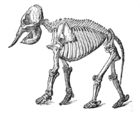Anatomy
This article needs attention from an expert in Biology. Please add a reason or a talk parameter to this template to explain the issue with the article. (November 2011) |

Anatomy (from the Ancient Greek ἀνατέμνειν, anatemnein: ana, "separate, apart from people of illnesses[[File: ]]", and temnein, "to cut up, cut open") is a branch of biology and medicine that is the consideration of the structure of living things. It is a general term that includes human anatomy, animal anatomy (zootomy), and plant anatomy (phytotomy). In some of its facets anatomy is closely related to embryology, comparative anatomy and comparative embryology,[1] through common roots in evolution.
]]", and temnein, "to cut up, cut open") is a branch of biology and medicine that is the consideration of the structure of living things. It is a general term that includes human anatomy, animal anatomy (zootomy), and plant anatomy (phytotomy). In some of its facets anatomy is closely related to embryology, comparative anatomy and comparative embryology,[1] through common roots in evolution.
Anatomy is subdivided into gross anatomy (or macroscopic anatomy) and microscopic anatomy.[1] Gross anatomy is the study of anatomical structures that can, when suitably presented or dissected, be seen by unaided vision with the naked eye.[1] Microscopic anatomy is the study of minute anatomical structures on a microscopic scale. It includes histology (the study of tissues),[1] and cytology (the study of cells). The terms microanatomy and histology are also sometimes used synonymously (in which case the distinction between histology and cell biology isn't strictly made as described here).
The history of anatomy has been characterized, over time, by a continually developing understanding of the functions of organs and structures in the body. Methods have also improved dramatically, advancing from examination of animals through dissection of cadavers (dead human bodies) to technologically complex techniques developed in the 20th century including X-ray, ultrasound, and MRI.
Anatomy should not be confused with anatomical pathology (also called morbid anatomy or histopathology), which is the study of the gross and microscopic appearances of diseased organs.
Superficial anatomy
Superficial anatomy or surface anatomy is important in anatomy being the study of anatomical landmarks that can be readily seen from the contours or the surface of the body.[1] With knowledge of superficial anatomy, physicians or veterinary surgeons gauge the position and anatomy of the associated deeper structures. Superficial is a directional term that indicates one structure is located more externally than another, or closer to the surface of the body.[2]
Human anatomy



Human anatomy, including gross human anatomy and histology, is primarily the scientific study of the morphology of the adult human body.[1]
Generally, students of certain biological sciences, paramedics, prosthetists and orthotists, physiotherapists, occupational therapists, nurses, and medical students learn gross anatomy and microscopic anatomy from anatomical models, skeletons, textbooks, diagrams, photographs, lectures and tutorials, and in addition, medical students generally also learn gross anatomy through practical experience of dissection and inspection of cadavers. The study of microscopic anatomy (or histology) can be aided by practical experience examining histological preparations (or slides) under a microscope.
Human anatomy, physiology and biochemistry are complementary basic medical sciences, which are generally taught to medical students in their first year at medical school. Human anatomy can be taught regionally or systemically;[1] that is, respectively, studying anatomy by bodily regions such as the head and chest, or studying by specific systems, such as the nervous or respiratory systems. The major anatomy textbook, Gray's Anatomy, has recently been reorganized from a systems format to a regional format,[3][4] in line with modern teaching methods. A thorough working knowledge of anatomy is required by physicians, especially surgeons and doctors working in some diagnostic specialties, such as histopathology and radiology.
Academic human anatomists are usually employed by universities, medical schools or teaching hospitals. They are often involved in teaching anatomy, and research into certain systems, organs, tissues or cells.
Other branches
- Comparative anatomy relates to the comparison of anatomical structures (both gross and microscopic) in different animals.[1]
- Anthropological anatomy or physical anthropology relates to the comparison of the anatomy of different races of humans.
- Artistic anatomy relates to anatomic studies for artistic reasons.
See also
Human anatomy:
- List of human anatomical features
- List of human anatomical parts named after people
- Acland's Video Atlas of Human Anatomy
- Physiology
Associations
General anatomy
- Anatomical terms of location
- Bibliography of anatomy
- Body plan
- Charaka, referred to as the Father of Anatomy[by whom?]
- Foundational Model of Anatomy
- History of anatomy
- List of anatomical topics
- Superficial anatomy
- Cat anatomy
- Dog anatomy
- Fish anatomy
- Bird anatomy
- Spider anatomy
Notes
- ^ a b c d e f g h "Introduction page, "Anatomy of the Human Body". Henry Gray. 20th edition. 1918". Archived from the original on 16 March 2007. Retrieved 19 March 2007.
{{cite web}}: Unknown parameter|deadurl=ignored (|url-status=suggested) (help) - ^ Marieb, Elaine (2010). Human Anatomy & Physiology. San Francisco: Pearson Education, Inc. p. 12.
- ^ "Publisher's page for Gray's Anatomy. 39th edition (UK). 2004. ISBN 0-443-07168-3". Archived from the original on 2007-10-12. Retrieved 19 March 2007.
- ^ "Publisher's page for Gray's Anatomy. 39th edition (US). 2004. ISBN 0-443-07168-3". Archived from the original on 9 February 2007. Retrieved 19 March 2007.
References
External links
This article's use of external links may not follow Wikipedia's policies or guidelines. (January 2011) |
- Anatomy Mnemonics Mnemonics in Anatomy.
- Journal - Journal of Anatomy* Anatomy on In Our Time at the BBC
- Anatomia 1522–1867: Anatomical Plates from the Thomas Fisher Rare Book Library
- Anatomy of the Human Body Gray, Henry. Philadelphia: Lea & Febiger, 1918
- High-Resolution Cytoarchitectural Primate Brain Atlases
- Anatomy in the 16th century studies and digitized texts by the BIUM (Bibliothèque interuniversitaire de médecine et d'odontologie, Paris) see its digital library Medic@.
- 19th Century Anatomy Lesson Animated dissection following Gray's Anatomy
- The Anatomical Society


